
Dubbed the “father of modern neurosurgery,” Dr. Harvey Cushing had a brilliant medical career. In 1901 he discovered what was later called the Cushing reflex—basically, what happens to your body when the brain is squeezed (That sounds way less science-y than it actually is, I swear). From there he continued to pioneer new ways of diagnosing brain tumors through X-rays, which produced new surgical techniques that drastically improved patients’ chances at survival from previously deadly conditions. Cushing also left a collection of about 500 preserved brains and nearly 10,000 patient photographs for posterity. In 2010—after sitting in a Yale dorm basement for more than 30 years—the brains were transferred to a museum, but it’s only recently that the pictures have been made available to the public.
The full series, titled “Cushing Tumor Registry,” covers Cushing’s patients from 1900 to 1933, and honestly if you had told me these were taken by Richard Avedon or Irving Penn, I wouldn’t have questioned it. The saturated, intense portraiture is stunning, whether focused on a pretty face or a brutal scar. Despite the medical nature of the photography, nothing in this cross-section elicits a shudder. Even the photo of the disembodied brain just looks like a still life.


More after the jump…





